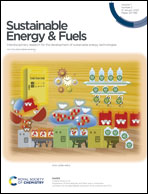A single-cell system of flow electrode capacitive mixing (F-CapMix) with a cross chamber for continuous energy production
Abstract
The generation of electricity from salinity difference energy between seawater and freshwater through a Capacitive Mixing (CapMix) system with solid electrodes was limited by intermittent energy production. In this study, a single-cell CapMix system using flow-electrode (F-CapMix) with a cross-chamber configuration was examined to produce electricity continuously from simulated seawater and freshwater. The effects of the flow-electrode electrolyte concentration, activated carbon loading, amounts of carbon black, and connected external resistance on the system performance were investigated. The results suggest that the system performance can be enhanced by increasing the activated carbon loading and carbon black amounts. Furthermore, to achieve the maximum power density of the system, the external resistance should be matched to the internal resistance. The maximum power density of the presented single-cell F-CapMix system was 74.3 mW m−2, which was comparable to those of previous CapMix and F-CapMix systems. In addition, this study also reveals that using only carbon black as the flow electrode is capable of producing electricity continuously for long-term operation. In summary, these results indicate the potential of F-CapMix and provide developing directions for further optimization.



 Please wait while we load your content...
Please wait while we load your content...